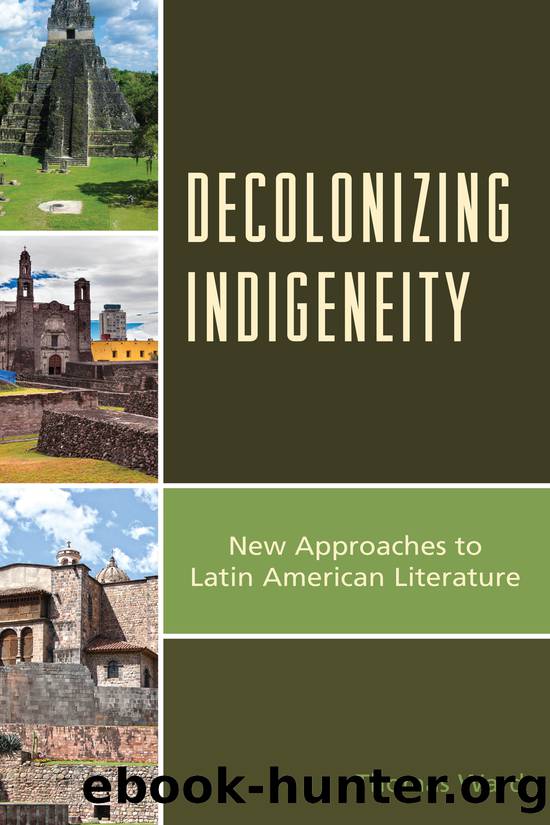Decolonizing Indigeneity by Ward Thomas;

Author:Ward, Thomas;
Language: eng
Format: epub
Publisher: Lexington Books/Fortress Academic
This chapter is adapted from âAlva Ixtlilxochitl, Civilization, and the Quest for Coevalness.â Studies in American Indian Literatures 23.1 (Spring 2011): 96â125.
Chapter 5
González Prada and Menchú
Indigenist and Indigenous Expression
As we saw in previous chapters, the chronicles of the sixteenth and seventeenth centuries and their derivative subgenres establish dualist cultural and legal categories including civilization and barbarism, knowledge (European) and nonknowledge (indigenous), vecinos (citizens) and tributarios (tax payers), Christians and heathens, and even proper-named nations and nation-denied indios (Indians). By inverting these asymmetrical dualist paradigms, we begin to extricate some of the gears of coloniality. This is exactly our course of action with the six attributes of âcivilizationâ in the chapter on Fernando de Alva Ixtlilxochitl. By examining the arrogance and ignorance of the heavy end of the hegemonic pole of cultural colonialism, we begin to reduce that endâs political weight by demystifying it, thereby allowing the suppressed end to peep out to a greater degree. This is what we accomplished in the chapter on AgustÃn de Zárate. Lastly, by forgetting the dualist pole all together, we can look at indigenous literature as indigenous literature and judge it on its own merits, free from cultural barometers imposed from other continents. Indeed, this was our approach with the Popol Wuj.
Framed differently, we can also state that we examined colonial Hispanism (a hegemonic perspective such as in Zárate), colonial Indigenismo (a defense of indigenous culture, as with Alva Ixtlilxochitl), and what I like to call Expresión IndÃgena, or Indigenous Expression (by and about Amerindians, as with the Popol Wuj). Hispanism has been a concept since Columbus, and Indigenism resurfaced full force during the nineteenth century, but authentic Indigenous Expression seems to have gone underground after the colonial interval and mostly stayed there until the mid-twentieth century. In this chapter, we will compare one manifestation of twentieth-century Indigenism with one manifestation of twentieth-century Indigenous Expression and take note of their concerns regarding various subordinating mechanisms that survived to the present by means of one epigonal colonial institution, the hacienda, a large landed estate. Specifically, we will review the prescriptions offered by both modes of expression that can serve as antidotes to the hacienda system as both strive for a new society, coloniality free, for the descendants of the first Americans.
Scholars who are striving for true and pure postcolonial standing must describe and analyze the insidious social mechanisms of the past to understand the present, despite the supposed history-free modernity of the present. Literary and nonliterary print media are one key to unpacking that past. The past is a rich archive indeed. The Popol Wuj came to take on the form, more or less, in which we know it today between the twelfth and the eighteenth centuries reflecting millenarian ideas and motifs from the high and lowland regions that participated in its composition. Zárate composed his chronicle in the middle of the sixteenth century revealing Hispanic ideas and preconceptions being imported into the Americas during that time frame. Alva Ixtlilxochitl penned his work early in
Download
This site does not store any files on its server. We only index and link to content provided by other sites. Please contact the content providers to delete copyright contents if any and email us, we'll remove relevant links or contents immediately.
The Power of Myth by Joseph Campbell & Bill Moyers(940)
Half Moon Bay by Jonathan Kellerman & Jesse Kellerman(921)
A Social History of the Media by Peter Burke & Peter Burke(888)
Inseparable by Emma Donoghue(855)
The Nets of Modernism: Henry James, Virginia Woolf, James Joyce, and Sigmund Freud by Maud Ellmann(773)
The Spike by Mark Humphries;(730)
A Theory of Narrative Drawing by Simon Grennan(717)
The Complete Correspondence 1928-1940 by Theodor W. Adorno & Walter Benjamin(712)
Ideology by Eagleton Terry;(666)
Bodies from the Library 3 by Tony Medawar(657)
World Philology by(650)
Culture by Terry Eagleton(649)
Farnsworth's Classical English Rhetoric by Ward Farnsworth(648)
Adam Smith by Jonathan Conlin(620)
A Reader’s Companion to J. D. Salinger’s The Catcher in the Rye by Peter Beidler(616)
Game of Thrones and Philosophy by William Irwin(604)
High Albania by M. Edith Durham(599)
Comic Genius: Portraits of Funny People by(588)
Monkey King by Wu Cheng'en(583)
